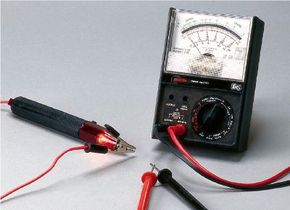A continuity tester consists of a battery in a housing, with a test probe connected to one end of the battery housing and a test wire with an alligator clip connected to the other end. It is used with the current turned off to determine whether a particular electrical component is carrying electricity and to pinpoint the cause of a problem.
To use a continuity tester, unplug the appliance and disassemble it to get at the component you want to test. Fasten the clip of the tester to one wire or connection of the component, and touch the probe to the other wire or connection. If the component is receiving electricity and transmitting it, the tester will light or buzz; this indicates that the circuit is continuous. If the tester doesn't light or buzz or it reacts only slightly, the component is faulty.
Advertisement
Caution: Do not use a continuity tester unless the appliance is unplugged or the power to the circuit is turned off.
Not what you're looking for? Try these:
- Home Repair Tools: Whether you prefer to use the Yellow Pages for anything that needs fixing around the house or consider yourself a regular do-it-yourselfer, there are a handful of tools that everyone should have in their tool box. Learn all about them in this article.
- Electrical Tools: In order to tackle basic electrical problems in your home, there are a handful of tools you'll want to have around. Learn about them in this section.
- Volt-Ohm-Milliammeter: For more serious electrical repairs, you'll want to invest in a volt-ohm-milliammeter, or VOM, which can measure an electrical current flowing through a wire. Check out this page for more on VOMs.
Advertisement
